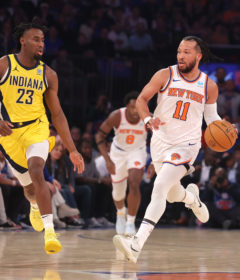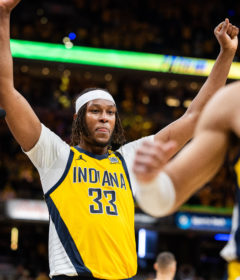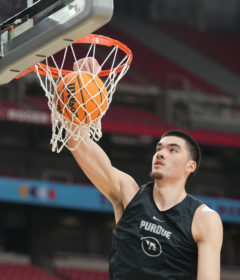Hoosiers season review: Moments, surprises and more

By CHRIS GOFF
ISL Assistant Editor
BLOOMINGTON, Ind. – It didn’t turn out the way they’d hoped, but the Indiana Hoosiers had some fun along the way. Let’s take a look back at their 2013 season.

Three Moments to Remember
1. Hoosiers 44, Penn State 24: For the first time in their history, the Hoosiers defeated Penn State, and it was as if the frustration of 16 losses was released all at once. The Hoosiers reeled off a 29-3 run in the middle of the second half.
Entering this Big Ten opener, the Hoosiers were reminded of their 5-35 record in conference play over the previous five seasons. They responded by winning as four-point underdogs. Walking off as 20-point victors, the Hoosiers stood at 3-2 and tied atop the conference, their season’s summit.
2. Boiled Boilers: The Hoosiers cooked up eight touchdowns and gained a school-record 692 yards against the inept Boilermakers, who finished 1-11 under first-year coach Darrell Hazell.
Indiana’s offense, led by Tre Roberson matching a school record with six touchdown passes, made life miserable for archrival Purdue, which suffered its worst loss ever against the Hoosiers and was down 40 at one point.
Hoisting the Old Oaken Bucket for the first time since 2010, Indiana left no doubt as to which school currently holds football supremacy.
3. Bolser passes Stephenson: Lined up in the right slot, Ted Bolser slipped inside a Purdue safety and easily caught a pass in the end zone for the reception that moved him past Indiana Football Hall of Famer Bob Stephenson as the Hoosiers’ all-time leader for catches by a tight end.
Afterward, Hoosiers players and coaches cheered as Bolser carried the Old Oaken Bucket over from the Purdue sideline in a fitting end to the fifth-year senior’s career. His 116th reception – he made one more to finish with 117 – was a reminder that Bolser also holds school marks for touchdowns and receiving yards by a tight end.
Three Moments to Forget
1. Heartbreak in Hoosierville: Against a reeling Minnesota defense that’d given up 26 points in 20 minutes, Indiana trailed 42-39 at home with the ball on the 9-yard line and under 30 seconds remaining. Everything – the play, the season – changed when Hoosiers quarterback Nate Sudfeld dropped back on second-and-goal and threw a lateral that was juggled and dropped by Tevin Coleman (later criticized by his coach for not falling on the loose ball).
The fallout: 1) Minnesota linebacker Aaron Hill recovered the fumble to seal the game, 2) the Hoosiers never got off a field goal to tie, much less a touchdown to win, 3) the Hoosiers sustained the loss that kept them from being bowl-eligible.
2. Yards by the Gallon: Waking up to overcast skies in Ann Arbor, Mich., the Hoosiers hardly could have known the aerial assault that awaited them at Michigan Stadium. Putting on his pads and cleats, Wolverines receiver Jeremy Gallon hardly could have known the name on the back of his jersey would soon go down in history.
Gallon toasted Hoosier defenders for 369 yards, a Big Ten record, on 14 catches and had two touchdowns, finishing with numbers Indiana coach Kevin Wilson referred to as “ridiculous.” Michigan had 63 points and 751 yards that day, stats Indiana safety Greg Heban called “embarrassing.” The Hoosiers’ offense put up 47 points. Play competent D, and the Hoosiers win.
3. Emblematic: Perhaps no game was a better microcosm of Indiana’s season than a 41-35 home loss to Navy in Week 2. The Hoosiers started poorly, outscored 17-0, allowed 444 yards on the ground and mounted a furious offensive surge that was as exciting as the defensive ineptitude was disappointing. The shootout included 996 combined yards of total offense. Beating the Midshipmen at Memorial Stadium was a doable task that Indiana let slip from its hands, triggering a 2013 campaign that amounted to one big missed opportunity.
Offensive MVP
Nate Sudfeld: Not an easy choice on a balanced offense with multiple quarterbacks. But Sudfeld’s passing was the largest part of Indiana setting team records for points and touchdowns in a season. Just a sophomore, Sudfeld threw for 2,523 yards and 21 TDs, amazing numbers. Over his first two years, he’s completing more than 60 percent of his passes. Sudfeld may not be a running quarterback, but he’s good with elite potential. If he can improve his short-range accuracy, Sudfeld can take this program closer to its ambitions.
Defensive MVP
Nobody: Each week, Indiana coaches named guys as the team’s top offensive, defensive and special teams players to reflect achievements in the last game. Three times they decided no one on defense was worthy of recognition. Really, that’s true for the season as a whole. This defense was too bad to have an MVP. Our choice might have been Greg Heban, who snared three interceptions, forced one fumble and recovered another, but he missed too many tackles. Linebacker David Cooper led the team with 85 stops.
Special teams MVP: Mitch Ewald was almost automatic. Despite missing two field goals off the uprights at windy Ohio Stadium, the kicker maintained his school record for accuracy. His final season (9-of-11) was one of his best. Honorable mention goes to Jake Zupancic, who was strong at both covering and setting up kick returns, as well as long snapper Matt Dooley, whose snaps were nearly perfect.
Three surprise players
Ralston Evans: When Peyton Eckert’s back started acting up in August, Evans, a 6-foot-4 sophomore lineman, soon became the choice to fill in at right tackle. Evans started all 12 games there. This from a guy who had played in a grand total of one game since finishing high school in the fall of 2010. Even on a surgically repaired knee, Evans was fluid and blocked with confidence and physicality. He was part of a line that allowed just 17 sacks despite being banged-up.
Tevin Coleman: He seldom touched the ball from scrimmage as a freshman in 2012 and was competing in training camp with senior runner Stephen Houston, who he unseated by Week 1. Thriving in Indiana’s spread offense, Coleman finished third in the Big Ten in yards per carry (7.3) and averaged 10.2 per catch. If not for a three-game absence caused by an ankle sprain, Coleman easily would have become Indiana’s first 1,000-yard rusher since 2001. Named honorable mention All-Big Ten, Coleman showed he’s hitting full-fledged stardom.
Tre Roberson: Roberson’s 2012 season was an unfinished book, with a major knee injury sidelining him after two sensational games against inferior competition. Roberson was a redshirt sophomore this fall and had shown impressive mobility. Given that backdrop, Roberson’s ability to succeed with his arm in 2013 was eye-opening. The quarterback, blending his speedy legs with improved pocket passing, hit 60 percent of his throws with just four interceptions in 138 attempts. Receivers loved him. “Great player,” Cody Latimer said.
Three disappointing players
Flo Hardin: Described in glowing terms by Doug Mallory, whose schemes hinged on him doing big things at outside linebacker, Hardin proved disastrously ineffective against both the run and the pass. Lining up in the slot as a cornerback so that Indiana could avoid using sub packages, Hardin fell well short of bringing the “excitement” Mallory hoped for. Had Hardin been benched sooner than the final game, the Hoosiers would’ve been a lot better off throughout their defense.
Mark Murphy: Though everyone knew Murphy wasn’t going to be a star, he unfortunately proved unreliable from week to week. Murphy was an experienced junior, but the more effective performer might have been freshman Antonio Allen, who tore an anterior cruciate ligament in the only game he started (at Michigan to open the second half of the season). The Hoosiers badly needed speed on defense and Murphy never looked fast. He wasn’t a ballhawk, wasn’t stout in run support, authored few big plays and missed too many tackles.
Nick Mangieri: To be fair, the former high school tight end had some really good moments. Mangieri accounted for an interception, a forced fumble and five pass break-ups. However, the end delivered only 1.5 sacks against FBS competition and struggled to generate pressure on opposing quarterbacks, who often had all day to throw. Through preseason camp and the opener, Mangieri had fans thinking he’d be a presence, but from that point onward, he wasn’t.
Top offseason issues
1. Cody Latimer and his future: Since the Hoosiers recruited Latimer out of Ohio in 2011, it’s been a marriage that has suited both sides well. Kevin Wilson’s scheme brings out the best in the talented Latimer, and Latimer has handsomely rewarded the team for taking a chance on a guy who had only played two years of organized football.
But Latimer’s receiving success, and three years of college play, have now made him a candidate for entry into the NFL draft. At the very least, he will explore the issue. Latimer said after the season ended that he wasn’t leaning one way or another. Losing Latimer early would be a blow to the offense. To apply, Latimer must renounce his final year of college eligibility. There is no going back.
2. Doug Mallory’s status: Wilson knows what to do on offense. He needs a strong lieutenant to take care of the defense. After a season in which Indiana gave up 38.8 points a game, he clearly is considering a change at defensive coordinator. When asked directly about the possibility of firing assistant coaches, Wilson declined to publicly defend Mallory or even to mention Mallory by name. Without answering the question, Wilson offered, “I expect a lot of changes because we have to get better.”
Mallory, who turned 49 last month, has been with seven college teams, including two stops with the Hoosiers. He was with the Hoosiers in 1994, ‘95 and ’96 and came back for the coordinator job in 2011 when Wilson was hired.
Wilson has to decide fairly quickly on the person who is going to run the defense next season. If not Mallory, Indiana could promote from within with William Inge or look around the country for a promising assistant coach. Mallory appears to be in trouble.
By the numbers
Let’s take a final numerical look at the Hoosiers, charting where they finished in a number of key statistical categories at the end of the 2013 regular season. For context, know that there are 125 teams in the Football Bowl Subdivision.
Points scored
Final rank: 19th (38.4)
Points against
Final rank: Tied 115th (38.8)
Total offense
Final rank: 11th (508.5 yards per game)
Total defense
Final rank: 123rd (527.9 yards per game)
Rushing offense
Final rank: Tied 32nd (201.8 yards per game)
Rushing defense
Final rank: 117th (237.8 yards per game)
Passing offense
Final rank: 18th (306.7 yards per game)
Passing defense
Final rank: 120th (290.2 yards per game)
Third-down offense
Final rank: 25th (86 of 184, 46.7 percent)
Third-down defense
Final rank: 112th (80 of 173, 46.2 percent)
Turnover differential
Final rank: Tied 81st (Minus-3 — 17 takeaways, 20 giveaways)
Red-zone offense (based on TD percentage)
Final rank: Tied 32nd (38 of 56, 67.9 percent)
Red-zone defense (based on TD percentage)
Final rank: 108th (36 of 52, 69.2 percent)
Follow Chris Goff on Twitter: chrisgoff_ISL.






